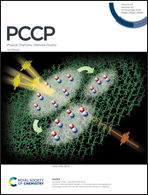Traveling waves propagating through coupled microbeads in the Belousov–Zhabotinsky reaction†
Abstract
Spatio-temporal patterns, namely global oscillations (GO) and traveling waves (TW), were investigated in spherical microbeads loaded with a catalyst for the Belousov–Zhabotinsky (BZ) reaction onto the surface (2D-loaded) or the entire volume of the bead (3D-loaded). GO and TW selectively appeared in the 2D- and 3D-loaded beads, respectively, placed on a polyethylene terephthalate (PET) sheet in the catalyst-free BZ solution. We examined two types of coupling of the two beads: 2D–3D and 3D–3D couplings. In both cases, synchronization occurred when the minimum distance between the two beads, l, was shorter than the threshold. Herein, we reported not only temporal information, that is, phase difference, but also spatial information, that is, the directions of the TW propagating through the coupled BZ beads. In the synchronization for the 2D–3D coupling, TW in the 3D-loaded bead were initiated from the point near the 2D-loaded bead as a pacemaker and propagated in the opposite direction. By contrast, the directions of the TW in the 3D-loaded bead changed depending on l in the synchronization for the 3D–3D coupling. These experimental results can be quantitatively reproduced by numerical calculations based on the diffusion dynamics of an activator of the BZ reaction. Our results suggest that the features of spatio-temporal wave propagation are indicative of the configuration of the oscillators.

- This article is part of the themed collection: 2021 PCCP HOT Articles


 Please wait while we load your content...
Please wait while we load your content...